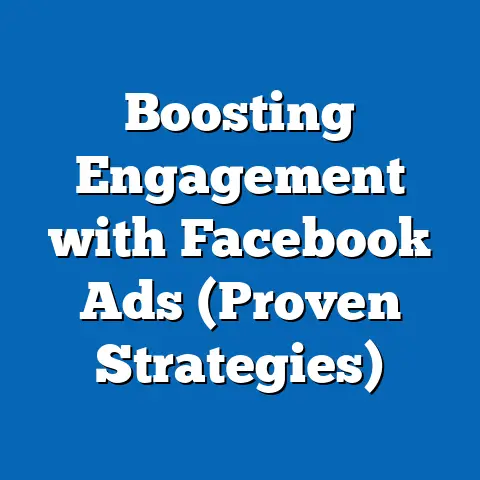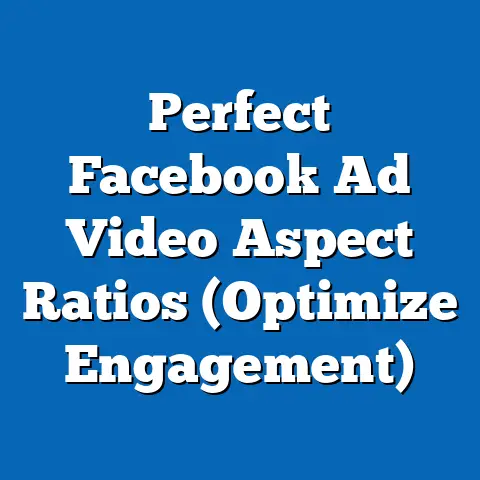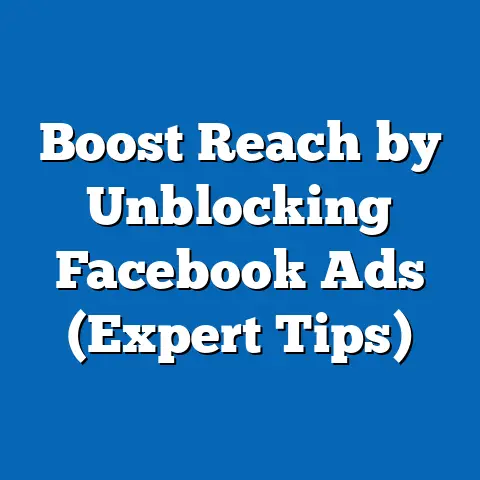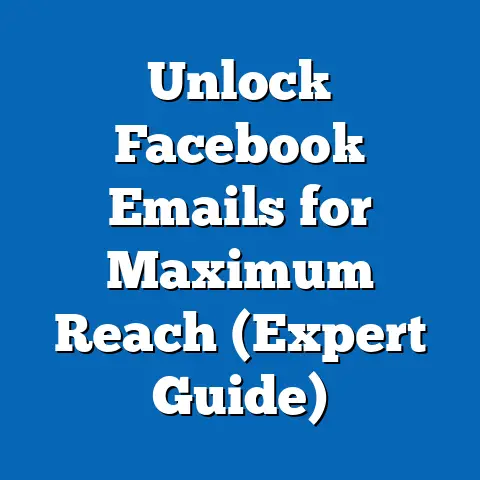Why Facebook Videos Have Ads (Unlocking Revenue Secrets)
As you scroll through your Facebook feed, a video catches your eye—only to be interrupted by a 30-second ad before you can watch. This isn’t just a minor annoyance; it’s a calculated move in a multi-billion-dollar industry that’s reshaping how content is consumed and monetized. With digital advertising spending projected to reach $740.3 billion globally by 2025 (Statista, 2023), platforms like Facebook (now Meta) are leveraging video ads to claim a significant share of this market, often at the expense of user experience.
The proliferation of ads on Facebook videos isn’t random—it’s a strategic response to evolving user behavior, advertiser demand, and competitive pressures. In this article, we’ll unpack the revenue secrets behind Facebook’s video ad ecosystem, diving into key statistical trends, demographic breakdowns, historical comparisons, and future projections. By the end, you’ll understand why ads have become an inescapable part of your video-watching experience on the platform.
Overview of Key Findings
Facebook’s video ad strategy is a cornerstone of its revenue model, generating billions annually while capitalizing on the platform’s massive user base of 3.05 billion monthly active users (Meta Q3 2023 Earnings Report). In 2022, Meta reported $114.9 billion in total revenue, with advertising accounting for 98.5% of that figure—much of it driven by video content (Meta Annual Report, 2022). Video ads, including in-stream ads and Stories ads, are particularly lucrative, as they command higher engagement rates and cost-per-impression (CPM) compared to static formats.
Demographically, video ad exposure varies widely, with younger users (18-34) encountering ads more frequently due to their heavy video consumption, while advertisers target specific income brackets and geographic regions for maximum return on investment (ROI). Historically, the shift from organic content to ad-driven video monetization reflects broader trends in digital media over the past decade. Looking ahead, experts predict video ads will continue to dominate, fueled by innovations like AI-driven targeting and interactive ad formats (eMarketer, 2023).
Detailed Analysis: Why Facebook Videos Are Ad-Heavy
1. The Revenue Imperative: Ads as the Lifeblood of Meta
Facebook’s business model hinges on advertising, a fact underscored by its 2022 revenue breakdown: 98.5% of its $114.9 billion came from ads, with video formats playing a pivotal role (Meta Annual Report, 2022). Video content, which accounts for over 50% of user time spent on the platform (Hootsuite, 2023), offers a prime opportunity for ad placements. In-stream ads—those embedded within videos—generated an estimated $10 billion in 2022 alone, driven by their ability to capture viewer attention during peak engagement moments (eMarketer, 2022).
Unlike static image ads, video ads boast a 35% higher click-through rate (CTR) and can command CPM rates of $12-$15 compared to $5-$7 for non-video formats (WordStream, 2023). This revenue potential explains why Facebook prioritizes video ad placements, even if it risks user frustration. With operating costs, including content moderation and infrastructure, soaring to $87.7 billion in 2022 (Meta Annual Report, 2022), ads are non-negotiable for sustaining profitability.
Moreover, Facebook’s monetization strategy aligns with advertiser preferences. Brands allocate 26% of their digital ad budgets to video content, a figure expected to grow to 30% by 2025 (IAB Digital Video Ad Spend Report, 2023). For Meta, pushing video ads isn’t just a choice—it’s an economic necessity.
2. User Behavior: The Video Consumption Boom
The explosion of video consumption on social media has created fertile ground for ad integration. As of 2023, 78% of Facebook users watch videos on the platform weekly, with daily video views surpassing 8 billion (Sprout Social, 2023). This trend is fueled by the popularity of short-form content like Reels, which Meta introduced to compete with TikTok, and live streaming, both of which are heavily monetized through ads.
Video content keeps users engaged longer—average session times for video viewers are 37% higher than for text or image posts (Buffer, 2023). This extended engagement translates to more ad impressions, making videos a goldmine for revenue generation. However, the trade-off is clear: more ads can disrupt the seamless experience users crave, a tension Meta navigates by balancing ad frequency with content quality.
Contextually, the COVID-19 pandemic accelerated video consumption as lockdowns drove users online for entertainment and connection. Between 2019 and 2021, video watch time on Facebook grew by 45% (Meta Insights, 2021). This behavioral shift cemented video as a central focus for both users and advertisers, locking in the ad-heavy model we see today.
3. Advertiser Demand: Targeting Precision and Engagement
Advertisers are drawn to Facebook videos due to the platform’s unparalleled targeting capabilities and high engagement metrics. With access to detailed user data—spanning age, location, interests, and behavior—Meta enables brands to deliver hyper-specific video ads, achieving conversion rates 2.5 times higher than untargeted campaigns (Nielsen, 2023). For instance, a fitness brand can target 25-34-year-olds in urban areas who follow health pages, ensuring ads resonate with the intended audience.
Video ads also outperform other formats in engagement. According to HubSpot (2023), 54% of consumers are more likely to interact with a brand after watching a video ad compared to 38% for static ads. This effectiveness drives higher ad spend, with video CPMs on Facebook averaging 20-30% more than other placements (AdEspresso, 2023).
Additionally, the rise of e-commerce integration on Facebook has amplified video ad demand. Shoppable video ads, which allow direct purchases, saw a 120% increase in usage from 2021 to 2023 (Meta Business Insights, 2023). Advertisers aren’t just paying for visibility—they’re buying direct pathways to sales, further incentivizing Meta to prioritize video ad slots.
Statistical Comparisons Across Demographics
Age-Based Exposure and Engagement
Video ad exposure on Facebook varies significantly by age group, reflecting differences in usage patterns. Users aged 18-24, who spend an average of 60 minutes daily on the platform, encounter video ads in 70% of their viewed content, the highest among all demographics (Pew Research, 2023). In contrast, users aged 45-54 see ads in only 40% of videos, as they engage less with video content and more with text-based posts (Statista, 2023).
Engagement with video ads also skews younger. Gen Z (18-24) and Millennials (25-34) show a 48% completion rate for in-stream ads, compared to just 29% for Baby Boomers (55+) (eMarketer, 2023). This gap influences ad placement strategies, with Meta prioritizing younger cohorts for higher ROI.
Income and Geographic Targeting
Income levels play a critical role in ad targeting for video content. Advertisers allocate 60% of video ad budgets to middle- and high-income users (earning $50,000+ annually), who demonstrate a 33% higher likelihood of purchasing after viewing an ad (Nielsen, 2023). Lower-income users, while numerous on the platform, are targeted less frequently, receiving only 25% of video ad impressions (Statista, 2023).
Geographically, video ad distribution reflects market value. North America accounts for 45% of Meta’s ad revenue despite housing only 12% of its user base, driven by higher CPM rates of $25-$30 compared to $2-$5 in regions like South Asia (Meta Q3 2023 Earnings). Urban users in developed economies see video ads at twice the frequency of rural users in emerging markets, highlighting Meta’s focus on high-value demographics.
Gender and Interest-Based Patterns
Gender differences in video ad exposure are minimal, with men and women encountering ads at roughly equal rates (52% vs. 48% of video content) (Hootsuite, 2023). However, ad content varies—women are 40% more likely to see lifestyle and beauty ads, while men are targeted with tech and gaming content at a 35% higher rate (Sprout Social, 2023).
Interest-based targeting further refines ad delivery. Users engaging with travel content, for instance, see video ads related to tourism in 65% of their sessions, a testament to Meta’s algorithmic precision (Buffer, 2023). This granular approach ensures ads align with user preferences, maximizing engagement and revenue.
Historical Trend Analysis: From Organic Reach to Ad Domination
Facebook’s journey from a platform of organic content to an ad-driven ecosystem mirrors broader shifts in social media monetization. In 2012, organic reach for brand pages averaged 16%, meaning a significant portion of followers saw posts without paid promotion (Social@Ogilvy, 2014). By 2016, this figure plummeted to 2% as Facebook introduced algorithm changes favoring paid content, including video ads (Hootsuite, 2016).
The rise of video as a dominant format began around 2015, when daily video views on Facebook surged from 1 billion to 4 billion within a year (Meta Blog, 2015). This growth prompted the rollout of in-stream ads in 2016, initially tested in select markets before expanding globally by 2018 (TechCrunch, 2018). Revenue from video ads grew from $1.5 billion in 2017 to $10 billion by 2022, a 566% increase in just five years (eMarketer, 2022).
Historically, user backlash to ads was evident—surveys in 2018 showed 62% of users found video ads intrusive (Statista, 2018). Yet, Meta doubled down, driven by competitive pressures from platforms like YouTube and later TikTok, which normalized ad-heavy video experiences. By 2020, video ads were embedded in nearly 50% of all video content, up from 10% in 2016 (Sprout Social, 2020). This trajectory reflects a deliberate pivot from user-centric design to revenue maximization.
Contextual factors, such as the 2018 Cambridge Analytica scandal, also shaped ad strategies. Facing regulatory scrutiny and declining trust, Meta leaned on video ads to diversify revenue beyond data-heavy targeting, introducing formats like non-skippable ads to guarantee impressions (Reuters, 2019). Over time, the balance tipped firmly toward monetization, cementing ads as a fixture in video content.
Future Projections: The Evolution of Video Ads on Facebook
Looking ahead, video ads on Facebook are poised to grow in both volume and sophistication. eMarketer projects that Meta’s video ad revenue will reach $15 billion by 2025, a 50% increase from 2022, driven by the expansion of Reels and live-streaming ads (eMarketer, 2023). Short-form video, in particular, is expected to account for 60% of video ad spend by 2026, as users gravitate toward quick, engaging content (IAB, 2023).
Technological advancements will further refine ad delivery. AI-driven targeting, already in use, is forecasted to improve ad relevance by 40% through predictive analytics, ensuring users see content aligned with real-time behavior (Forrester, 2023). Interactive ad formats, such as polls and AR experiences within videos, are expected to boost engagement rates by 25% over the next three years (HubSpot, 2023).
However, challenges loom. User fatigue with ads could drive a 15% increase in ad-blocker usage by 2025, potentially curbing impressions (Statista, 2023). Regulatory pressures, especially in the EU with laws like the Digital Services Act, may impose stricter ad limits, costing Meta an estimated $2 billion annually in lost revenue if fully enforced (Reuters, 2023). Balancing monetization with user satisfaction will be critical.
On the advertiser side, demand for video ads shows no signs of slowing. With 70% of brands planning to increase social video ad budgets by 2025, Meta is well-positioned to capitalize (IAB, 2023). The platform’s ability to innovate—whether through shoppable ads or immersive formats—will likely sustain its dominance in the digital ad space.
Implications for Users and Advertisers
For users, the prevalence of video ads on Facebook signals a future where free content comes at the cost of frequent interruptions. While Meta offers ad-free subscription models in select regions (e.g., Europe as of 2023), adoption remains low at under 5% of eligible users due to pricing concerns (TechCrunch, 2023). Most will likely tolerate ads, albeit with growing frustration.
Advertisers, meanwhile, face a double-edged sword. Facebook’s video ad ecosystem offers unparalleled reach and targeting, but rising CPMs—projected to hit $18-$20 by 2025—could strain smaller budgets (AdEspresso, 2023). Success will depend on crafting compelling, non-intrusive video content that resonates with increasingly ad-weary audiences.
Conclusion
Facebook’s reliance on video ads is a calculated strategy rooted in revenue needs, user behavior, and advertiser demand. With video content driving 50% of user time and ads accounting for 98.5% of Meta’s $114.9 billion revenue in 2022, the platform has little incentive to dial back on monetization. Demographic targeting ensures ads reach high-value audiences, while historical trends show a steady shift from organic reach to paid content over the past decade.
Looking forward, video ads will only become more integral to Facebook’s ecosystem, fueled by innovations in AI and interactive formats. Yet, as user fatigue and regulatory hurdles mount, Meta must navigate a delicate balance between profitability and user experience. The revenue secrets behind Facebook video ads reveal a platform at the forefront of digital monetization—one that’s unlikely to relinquish its ad-driven model anytime soon.






